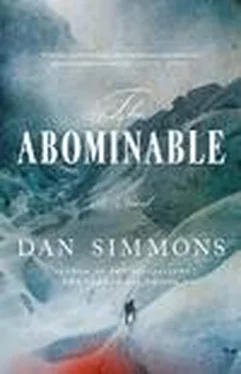Jean-Claude only nods, and I sense how very tired he is.
The three miles of climbing between Rongbuk Base Camp and Camp I amounts to hiking uphill on lateral moraine beds and across fields of shallow ice between hundreds of the penitente ice pillars. The three uphill miles between Camp I and Camp II are a mixture of moraine and actual glacier crossing, but the majority of the way is along the Trough among and between the ice pinnacles at the bottom of the valley. But almost all of the almost five hard miles uphill from Camp II here to Camp III at the base of the wall is on the ever more steeply rising glacier.
And the glacier is filled with hundreds of crevasses covered over with new snow.
I’ve followed J.C. for two days now as he’s threaded our route through those invisible crevasses, leaving only our footsteps in the deep snow—much of the time Jean-Claude was breaking trail through snow up to his thighs or waist—but also marking that route with wands and fixed ropes for the steeper parts.
Both days have been sunny, and through my goggles the glacier snowfields are merely a maze of sastrugi drift-ripples and corresponding blue shadows everywhere. Some of those blue shadows are shadows. Many are crevasses under their thin coverings of snow—gaps that would drop a man (or woman) hundreds of feet into the heart of the glacier. Somehow Jean-Claude always seems to know which shadow means what.
Twice between Camps II and III we’ve had to detour around crevasses too extensive to flank. The first time, yesterday, J.C. finally found a snow bridge that he judged would hold our weight. Jean-Claude crossed first while I belayed, my ice axe sunk deep in the ice, and then we rigged two strong, waist-high guide ropes across along with jumars that would carabiner onto the Sherpas’ new climbing harnesses.
The second crevasse had no snow bridges, and trying to detour around it either way just led us into endless fields of more hidden crevasses. Finally I belayed J.C.—while the Sherpas belayed me—with an extra ice axe laid across the lip of the crevasse so the rope would not cut into the snow. Jean-Claude used his new, short ice axes and 12-point crampons to descend 60 or 70 feet into the terrible crack until he reached a point where the walls were close enough together that he could take one huge step (for a short man) and slam his right ice hammer and right crampon front blades into the opposing ice wall. Then he swung his left arm and leg across a widening abyss that dropped into absolute darkness, kicked both crampon fronts into the blue ice wall, and began climbing with his short axes smacking into ice, each one higher than the other, up the opposite wall.
Once J.C. climbed out and was standing on the other side of the crevasse, I threw a coil of strong rope across and then two of the long ice axes, which he used to anchor the ropes. Then I used two axes and several long ice screws to anchor the ropes on our side of the crevasse. J.C. was wearing one of the climbing harnesses that none of us had tried on the mountain yet, and now he clipped carabiners from the harness onto one of his jumar thingies, lifted his cramponed boots up and over the rope, and just scooted hand over hand, butt first, back toward us along the doubled rope across the bottomless drop as if he were a child on a playground.
“The Sherpas can’t do that with their loads,” I gasped out when he unclipped from the ropes and moved away from the treacherous edge.
Jean-Claude shook his head. He’d been doing all the climbing and work, and I was still the one gasping and panting. “We have our fine fellows dump their loads here for now and we go back to Camp Two. Reggie should have had her team of nine porters bring up the ladders to Two by now. We lash two of the ten-foot ladders together, provide guide ropes as we did on the snow bridge, and… voilà! ”
“Voilà,” I repeated with less enthusiasm. It had been a long, hard, dangerous climb up the glacier to this point, we were less than two-thirds of the almost five miles to Camp III, and now we had to head back down to Camp II to start hauling up ladders and more rope. The Sherpas with us were grinning. They’d had enough of hauling loads for one day and were more than happy to dump their heavy loads and walk unencumbered back down the safely wand-marked glacier.
The Deacon had warned us that this was how all the previous expeditions’ planning and schedules, including Mallory’s the year before, ended up in disarray, with loads being dumped up and down the entire eleven-mile Trough and glacier trek up to Camp III and the North Col. All the military planning in the world, he said, can’t overcome the inherent chaos of crevasses and sheer human exhaustion.
“We need more wands anyway,” J.C. said. It was true. There were so many crevasses that Jean-Claude’s route up the glacier twisted this way and then that, rarely a simple straightforward route along the three and a half miles or so we’d covered. We’d underestimated the number of bamboo wands we’d need to mark the route accurately enough for porters following—especially in a snowstorm.
But by early afternoon of this Tuesday, the fifth of May, we have our loads safely delivered to Camp III. Crossing 15 feet or more of the lashed-together wooden ladders above the endless crevasse drop with only the waist-high guide ropes to steady us on our crampons had been an experience I didn’t look forward to having again (though I knew I would have to, many times). We’ve erected J.C.’s and my small Meade tents and Reggie’s hemispherical Big Tent in anticipation of the scheduled rush of men and matériel to come. For tonight, the four Sherpas can sleep in it.
The plan is for us to spend this one night here, waiting for Reggie’s Tiger Team Two with nine Sherpas and their loads, scheduled to arrive before noon tomorrow, and then some of us are to continue waiting—and acclimating—at Camp III until the Deacon comes up the next day, Thursday, May 7, with Tiger Team Three. Only then, according to the plan, and perhaps with even one more day of acclimation for some of us, can anyone attempt to tackle the 1,000-foot slope and wall up to the North Col. Mostly, I think to myself, because the Deacon doesn’t want anyone to climb onto the North Col until he’s present and—presumably—leading the climb.
The real headache hits me before darkness fully falls on this Tuesday night.
I’ve had a headache since we reached Base Camp far below, but suddenly it feels as if someone is driving an ice screw into my skull every thirty seconds or so. My vision flutters, dances with black dots, and begins to constrict into a tunnel. I’ve never had a migraine headache in my life—only two or three serious headaches of any sort that I remember—but this is terrible.
Not bothering to layer into my goose down or outer jackets or to pull on my gloves or overmittens, I crawl on all fours out of the flapping tent, turn away from where we’d staked out the other, larger tent, and vomit behind the closest boulder. The headache makes me continue to dry retch even after my stomach is empty. Within seconds, my hands are freezing.
Dimly, distantly, I realize three things: first, the wind has come up so strongly that the small Meade tent J.C. and I have been crouching in is flapping and banging like wash hung out to dry in a hurricane (I’d thought the noise was only in my throbbing skull); second, that along with the wind have come deeply freezing temperatures and a blizzard so intense that I can barely see the Big Tent eight feet away; third and finally, that Jean-Claude has pulled on his Finch duvet jacket and, leaning out of our tent’s opening, is screaming for me to come back inside.
“Vomit in here, Jake, for the love of Christ!” he is shouting. “We’ll toss the basin out. If you stay out there another minute you’ll be fighting frostbite for a month!”
Читать дальше












